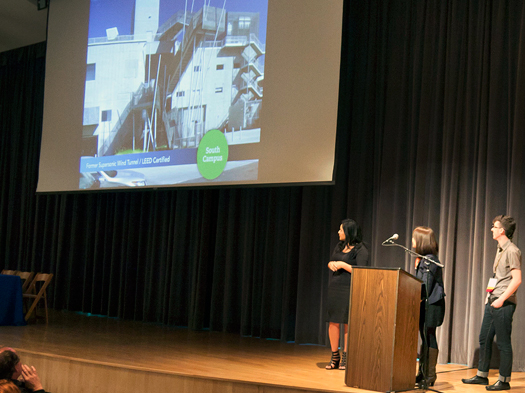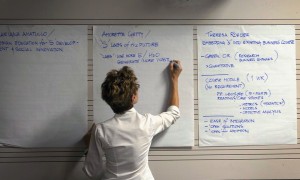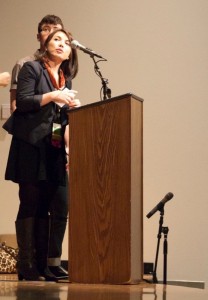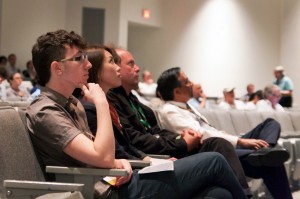
Photo by Dice Yamaguchi
The scope of design is rapidly expanding in leaps and bounds. Today’s designers feel a responsibility to address environmental, social and economic needs with their work more than ever before. In light of the changes taking place in recent years, Art Center has been developing a comprehensive design curriculum and its importance has been underscored in the school’s five-year strategic plan.
Art Center students Jessie Kawata and Yan Kramsky are co-presidents of the student-run group EcoCouncil, which has been largely responsible for helping green the College and introduce sustainable initiatives throughout the campus and curriculum.
The two were featured keynote speakers at last week’s California Higher Education Sustainability Conference. Together, they led the final presentation of the conference, sharing their perspectives on sustainable design and reflections on the event. Earlier in the conference, Vice President of Designmatters Mariana Amatullo participated in a panel discussion moderated by Associate Professor and Director of Sustainability Initiatives Heidrun Mumper-Drumm titled Embedding Sustainability into Existing Curriculum.
Kawata and Kramsky took some time out of their busy schedules—they graduate next month!—to talk with Dotted Line about EcoCouncil, comprehensive design and what they hope people took away from their presentation.
Dotted Line: Just what is the California Higher Education Sustainability Conference?
Jessie Kawata: Students, educators, staff and administrators from community colleges, four-year colleges, public and private schools come together to talk about sustainability and various Climate Action Plan (CAP) initiatives in higher education. It was held in Long Beach.
We were one of the few private colleges to attend, and we were the only featured speakers from a private school—not to mention Art Center was the only art and design college present. So it was a real honor for both of us to be involved.
Dotted Line: How did the opportunity for you two to be keynote speakers come about?
Yan Kramsky: Heidrun Mumper-Drumm suggested that we apply. It’s funny, we didn’t realize we were applying to be keynote speakers, just workshop speakers, so we were surprised and honored to be selected as keynotes.
We have experience with sustainability initiatives from a grassroots perspective through our work with EcoCouncil, and I think we are the types of students that they were looking for, who could share our specific experiences.
Kawata: We were definitely surprised, because the proposal and presentation we sent to apply aren’t what they normally receive—it was a joint presentation and not just one speaker, for one thing. Our approach, based on our experiences as design students, was very out-of-the-box and new to them. And we feel they accepted our idea with open arms, which is great.
Dotted Line: What did you speak about at last week’s conference?
Kramsky: In a nutshell, the relevance of sustainability within design, and the shift that’s happening within industries. We talked about Art Center, some of the changes that have taken place here, like the College’s Zero-Waste plan, the role of sustainability in the new strategic plan, and the newly opened community garden.
Kawata: Designers have a unique way of viewing and solving problems. We tried to show participants the opportunities that exist between what they do and what we do as designers.

Photo by Dice Yamaguchi
It’s a concept many hadn’t considered before.
Dotted Line: So how did the presentation go?
Kramsky: It went well, minus a few technology-related glitches. The conference largely confirmed my belief that most don’t yet have a grasp of where the intersection between sustainability and design lies.
It was really nice to hear from other students who encountered similar experiences when attempting to integrate sustainability into the pedagogy and infrastructure of their school. I hope that they learned from us as much as we learned from them.
Kawata: I think that people left with a sense of curiosity and insight, which is what we wanted. Hopefully in the future, design can play a bigger part in these types of educational conferences.
Also, I learned how essential campus collaboration is between student organizations and administration to achieve success. Being able to speak with other students about their own campus sustainability experiences was both helpful and empowering.
Dotted Line: What do you hope people took away from your presentation?
Kramsky: Hopefully they left realizing that design is very much a part of sustainability, and that good design can help their campuses achieve their sustainability goals and how we can collectively make smarter choices.
Kawata: I hope we provided informative inspiration, and that participants better understand the role of design and sustainability. And that a lot of the environmental problems that we’re facing today can be solved through design.
Dotted Line: Tell us about sustainability on campus, and being involved in EcoCouncil.
Kawata: I think that students are realizing that sustainability and sustainable practices are increasingly relevant not just on a personal level, but in our educations and subsequent careers as well.

Photo by Dice Yamaguchi
We’re realizing that sustainability is a part of the bigger picture—it’s not just a practice, but a lifestyle. You really have to adapt yourself and your actions.
Kramsky: We’ve been very involved with the student-run group EcoCouncil, which has led the way in developing and implementing creative, environmentally responsible solutions to life at Art Center. We’re working to fully implement sustainability throughout all aspects of the school, including infrastructure, operations, curriculum and student life.
Kawata: What EcoCouncil wants is to bring change and awareness. For instance we worked with the Cafeteria and College administration to create the Zero-Waste Initiative, which introduced composting and aims to reduce waste by 90 percent.
Dotted Line: You graduate next month. What’s next for both of you?
Kramsky: I’m looking to join a place that focuses on environmental and social sustainability. Many of my projects have focused on educational and medical tools and environments, so I’m interested in continuing in this direction. But I’d also be interested in working with a company that’s struggling with sustainability and helping them find effective solutions.
Kawata: I would love to be a part of a company or organization that holds value in creativity, education, sustainability and social change. After graduation, I’m hoping to continue my efforts in discovering how design can have a positive impact on the environment.









